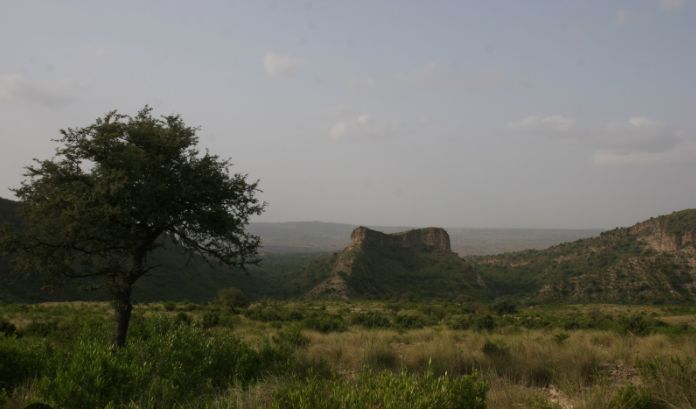By Shumaila Noreen/Ali Jabir
ISLAMABAD, Feb 4 (APP): After playing havoc with people of plains, this foggy and misty weather also engulfed the iconic federal capital and mesmerizing mountain ranges with treasures of history and primeval civilizations.
The rain fed region of Pothohar Plateau this season witnessed an unprecedented spell of perpetuated foggy days since the onset of winters that is being attributed to a complex mechanism of multiple atmospheric dynamics and large-scale inversions in the weather patterns.
The intricate problem requires a lucid explanation to grasp the gist of matter as ‘Fog’ is formed when air cools to dew point, the temperature at which water vapor condenses into tiny droplets.
This cooling of air is influenced by radiative balance, wind speed, humidity and topography of the land. The air pollution, consisting of aerosols and particulate matter from various sources like biomass burning, industrial emissions and vehicular exhaust, acts as nuclei for condensation of water vapor and reduces visibility by scattering and absorbing the sunlight.
“The prevailing foggy weather was mainly due to atmospheric dynamics as natural elements and anthropogenic activities resulted in anomalous climatic behavior,” said Head of Department, Institute of Environmental Sciences and Engineering (IESE), Dr Muhammad Fahim Khokhar.
“It was too early to call this phenomenon an outcome of climate change. However, due to shift of western disturbances towards South caused dry spell in North India and Pakistan resulting in anthropogenic activities and thick fog,” he explained.
He also described uncontrolled burning in Pakistan and emissions thereon as the cause of thick fog. “It’s a complex mechanism where multiple atmospheric dynamics and large-scale inversions in weather caused prolonged fog.”
The major impact in the prolonged foggy days was of natural forcing whereas the rest was anthropogenic activities that aggravated the crisis.
Experts at the Climate Change Ministry believe that increase in foggy days was due to delayed winter rains and snowfall.
They see the ‘Fog’ impacting economy, health, agriculture and travelling modes like railways, aviation and road transport causing billions of dollars losses in material and psychological burden and respiratory ailments.
“Foggy days visibly increased because rainy days were miniscule across the country and snowfall that was expected during month of November had delayed,” stated Climate Change Ministry Spokesperson, Saleem Sheikh. “Reduced number of rainy days is the major cause of prolonged fog in Pakistani plains and the federal capital.”
He said Pothohar is a rainfed plateau and delayed downpour and fog also affected arid agriculture in this region. “Wheat cultivation in Pothohar usually starts from November 15. But, this time the seeds could not germinate due to less moisture.”
He said the agronomists are indicating less wheat produce in Pothohar as it is anticipated that roughly an over 60% more foggy days were witnessed this summer in Pothohar than the previous years.
Thick fog was witnessed all around in areas of KP, Punjab and Sindh as foggy days also resulted in prolonged vacations at Punjab and Islamabad schools. The weather remained murky due to persistent fog causing bone chilling winters in these areas.
“Persistent fog in northern regions including north India broke all records since the beginning of daily monitoring of satellite data in 2014,” remarked Director General Pakistan Meteorological Department, Mehr Sahibzad Khan. “The thick fog layer sometimes engulfs entire swathe of over 2,500 km from Lahore to Dhaka (Bangladesh).”
This winter, misty conditions and low cloud cover has lasted for more than a month at a stretch, making it the longest fog spell in a decade. The scientific reason of prevalence of fog in plains of India and Pakistan during 2023 and 2024 is related to atmospheric conditions and air pollution in the region.
“This insufficient rainfall has created a drought like situation in the region as rainfall and snowfall are considered the main sources of water for agriculture, hydroelectric power and domestic use,” Khan said.
The rainfall and snowfall patterns, he said are affected by the large-scale atmospheric circulations, regulated to sea surface temperature of large water bodies (oceans) that are influenced by global climate change and regional variability.
“The regional variability, related to natural oscillations of climate system, such as El Niño-Southern Oscillation, the Indian Ocean Dipole and North Atlantic Oscillation also modulates rainfall and snowfall distribution and frequency over the region,” Sahibzad added.
He enunciated that in yesteryears Indian Ocean Dipole (IOD) remained in its positive phase and kept on nourishing Pakistan with a relatively consistent supply of moisture from Arabian Sea as in winters of year 2023/2024 IOD transitioned from positive phase to neutral. “This halted supply of moist winds that were facilitating rainfall across Pakistan in collaboration with westerly trough.”
The unusual intensity of fog this winter is likely due to the combination of meteorological factors and anthropogenic factors, he said. “The meteorological factors like low temperature, high humidity, the calm wind and stable atmospheric layer are influenced by the climate change and favor the formation and persistence of fog.”
The anthropogenic factors, he said, are high concentration of pollutants like sulfur dioxide, nitrogen oxides, carbon monoxide and black carbon that are influenced by population growth, urbanization, industrialization and energy consumption.
As Pakistan is under serious threat of changing weathers, individual and regional level steps were direly needed to avert recurrence of such phenomenon and overall climate change effects.
APP/snk-ajb/maz






